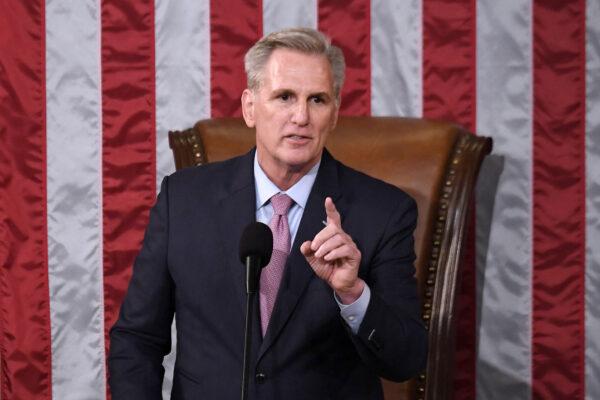Rep. Kevin Hern (R-Okla.) has outlined the policies Republicans are discussing in connection with debt ceiling negotiations, which include rollbacks on discretionary spending, a cap on future spending, and ‘paid-for’ tax cuts.
Hern, who chairs the House Republican Study Committee (RSC), listed the policy ideas in a letter to committee members on Feb. 1.
Republicans have said they will ask for spending cuts in exchange for raising the debt ceiling but have so far declined to name the areas targeted for reduction.
The RSC letter, the contents of which were obtained by The Epoch Times, states the policy areas have been “endorsed for discussion” in connection with debt ceiling negotiations, offering a preview of Republican intentions.

House Speaker Kevin McCarthy has repeatedly stated his determination to gain spending cuts alongside any increase in the $31.4 trillion national debt.
The RSC letter indicates Republicans may try to make any increase to the debt ceiling contingent on a more-or-less equal reduction in spending.
President Joe Biden has repeatedly said he would not negotiate on whether or not to increase the debt ceiling because it would put the credit of the country at risk.
However, Biden and McCarthy met to discuss the matter on Feb. 1.
Republicans have said they would like to reduce discretionary spending to pre-2022 levels, which would require cuts of about $100 billion. They will begin by targeting fraud, waste, and abuse, and “the Democrats’ recent excessive spending.”
They will not target mandatory entitlement programs such as Social Security and Medicare for spending reductions. Those programs totaled $2 trillion in 2021, which was $400 billion more than all discretionary spending programs combined.
Stimulating Economic Activity
“Paid-for” tax cuts are intended to have a neutral or positive effect on the budget by stimulating economic activity, thereby generating at least as much new tax revenue as was lost, all while growing the economy.Experts disagree on how well that works.
Cutting taxes rarely pays for itself in full, according to the Tax Policy Center, but the loss may be offset by some new revenue.
For example, the 2017 Tax Cuts and Jobs Act (TCJA) did not generate enough new revenue to offset the loss created by cutting taxes, according to William Gale, a senior fellow in economics at Brookings.
Comparing actual tax revenue for 2018 with revenue projections made prior to the tax cuts, Gale identified a $275 billion drop in revenue.
“Given that the economy grew, and in the absence of another policy that could have caused a large revenue loss, the data imply that the TCJA substantially reduced revenues,” Gale wrote.
Preston Brashers, a senior policy analyst at The Heritage Foundation, concluded that the long-term effect of TCJA would be positive over a decade of projected revenue increases.
“It doesn’t look like the tax cuts—which government scorekeepers said at the time would cost $1.5 trillion over 10 years—have been anything like the fiscal nightmare that some on the Left would lead us to believe.”
The essential difference between mandatory and discretionary spending is that discretionary spending requires annual authorization by Congress. Mandatory spending continues from year to year unless Congress decides to alter it.
Mandatory spending includes so-called entitlement programs such as Medicare, Social Security, and Medicaid. Non-entitlement mandatory spending includes things like interest on the national debt, student loan programs, and unemployment compensation.
Ability to Repay
Republicans are considering establishing a cap on the national debt as a percentage of the economy rather than a dollar amount. The aim of this idea is to keep the debt from growing beyond the country’s ability to repay it.This would ensure that certain bills would always get paid, regardless of increases to the debt ceiling. The RSC letter lists national defense, veterans programs, Social Security, and Medicare as examples.
The GOP also wants to reduce regulatory barriers for the energy industry making it easier to get approval to increase oil production, which would likely reduce the price of gas and could stimulate the economy.
This policy is in response to what Hern called an “all-out assault on affordable American energy” by the Biden administration.
Since the United States has operated on a deficit budget in all but four years since 1970, ongoing borrowing is required to meet the spending obligations already passed by Congress.
The United States approached its debt ceiling in January. To forestall a financial crisis, U.S. Treasury Secretary Janet Yellen took “extraordinary measures” to keep the nation below that limit until sometime in June.





